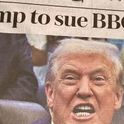President Donald Trump signs an Executive Order instructing his as-yet-unconfirmed Treasury Secretary to look at financial regulation ©Aude Guerrucci/DPA/PA Images
Around nine years ago, the US investment bank Bear Stearns was in trouble, finding increasing reluctance on the part of markets to provide the liquidity it needed to continue operations. In March 2008 the Federal Reserve intervened heavily to give the bank a lifeline. Two months later, the bank was no more, sold for a song to JP Morgan Chase. With the Lehman crisis four months away, the rest, as they say, is history.
Yet 10 days ago, President Donald Trump issued an executive order which instructs his yet-to-be-confirmed Treasury Secretary and US financial sector regulators to report in June about whether and how to undo the significant parts of that history that have to do with banking regulation. Trump’s executive order doesn't refer to the landmark Dodd-Frank Wall Street Reform and Consumer Protection Act by name but this is what is in the Trump Administration’s cross-hairs. Trying to unpick it is the finance sector equivalent of undoing Obamacare.
It’s worth pointing out that Trump, himself, can’t change finance sector regulation. Only Congress can do that, including the Senate where the Republicans have a 52:48 majority, and need 60 votes to avoid a “filibuster,” or lengthy and sometimes permanent delay. Getting enough Democrats to support financial deregulation is going to be hard, if not impossible. But Republicans are going to give it a try, as Trump directs his investment banker poachers-turned-gamekeepers, such as Gary Cohn, Chief Economic Adviser, Steve Mnuchin, Treasury Secretary nominee, and White House Chief Strategist Steve Bannon.
Dodd-Frank was a creature of its time. It subjects banks to higher capital and liquidity requirements, and banks are now much better resourced and structured. It requires the 34 banks that qualify as SIFIs (or systemically important financial institutions, according to asset size) to be stringently stress-tested. It set up a Financial Stability Oversight Council as a mechanism to wind down large failing financial service companies, banned banks from proprietary trading (the so-called Volcker rule), and introduced a raft of consumer protection reforms under the auspices of the Consumer Finance Protection Bureau.
Critics complain that Dodd-Frank is unwieldy, providing 400 rules in a law that extends to 848 pages, that it represents government over-reach in the extreme, and that smaller banks are severely disadvantaged by the weight and cost of regulation. They resent the expanded authority of consumer finance regulators who oversee, for example, mortgages, student loans and credit cards. They think that the weight of regulation is restricting lending, making it highly concentrated in areas, and limiting economic growth and job opportunities.
The claims that smaller banks, community banks, and credit unions, for example, might have been stymied needlessly by Dodd-Frank are certainly worth investigating. But there is no general case to justify US financial sector deregulation, especially within a decade of the last severe financial crisis. The argument is ill-conceived, ideological and dangerous.
Take Trump’s rather naive justification of his executive order. He said “I have so many people, friends of mine, who have nice businesses who can’t borrow money. They just can’t get any money because the banks just won’t let them borrow, because of the rules and regulations in Dodd-Frank.” You don’t have to dig very deeply to establish this is nonsense.
If there were a serious impediment to growth and jobs because of miserly banks, you’d find it among small businesses. Yet the National Federation of Independent Businesses reported in December a surge in business optimism, and no sign at all that small businesses were being starved of credit. If anything, the problem is not a shortage of credit supply, but of credit demand. 67 per cent of respondents said they had no interest in borrowing.
The quarterly Senior Loan Office Opinion Survey published by the Federal Reserve, and a great leading indicators of the financial crisis, similarly reported in October no evidence of tight or restrictive credit conditions applied to mortgage or commercial loans by the nation’s major lending institutions.
In the Fed’s regularly published statistics, we can see that commercial and industrial loans have grown by 8.5 per cent at an annual rate since the post-crisis nadir in 2010, and are a third higher than in October 2008. Consumer credit has grown by 6.5 per cent at an annual rate since 2012. These growth rates are far in excess of the underlying rate of nominal GDP growth. The only weak spot has been mortgage lending, where mortgage debt outstanding is only $300bn higher now than the point of the post-crisis trough in 2014. But then, no one would expect households to re-engage so soon with the product that was at the heart of the crisis. Even at generational lows in mortgage rates, households simply don’t want to build exposure to mortgages, not in the US, or many other countries that were hit badly less than a decade ago. Anyway, the demographics are changing as the prime-age first time buyer cohort weakens.
If you need any further demonstration of the US government’s intentions when it comes to financial sector regulation, you should note that Trump has also issued an executive order to the Labour Department to delay implementation, scheduled for April, of the “fiduciary rule,” which requires professional financial advisors, who charge commissions, to put their clients’ best interests first when advising on retirement provision. This means they must recommend a lower over a higher commission product if one is available and appropriate. The complaint is that this restricts choice to buyers. But more choice in a world of low financial literacy is an invitation to exploit. We have been here before.
In the election campaign, Trump was happy to pose as the champion of the working class against a ruthless and controlling Wall Street. He isn't that and the financial sector is more tame and more controlled than it was. Its stronger balance sheets should not be compromised and if anything could be strengthened further. Trump is taking unnecessary risks with financial stability if he goes further than tweaking Dodd-Frank.












